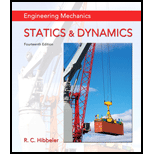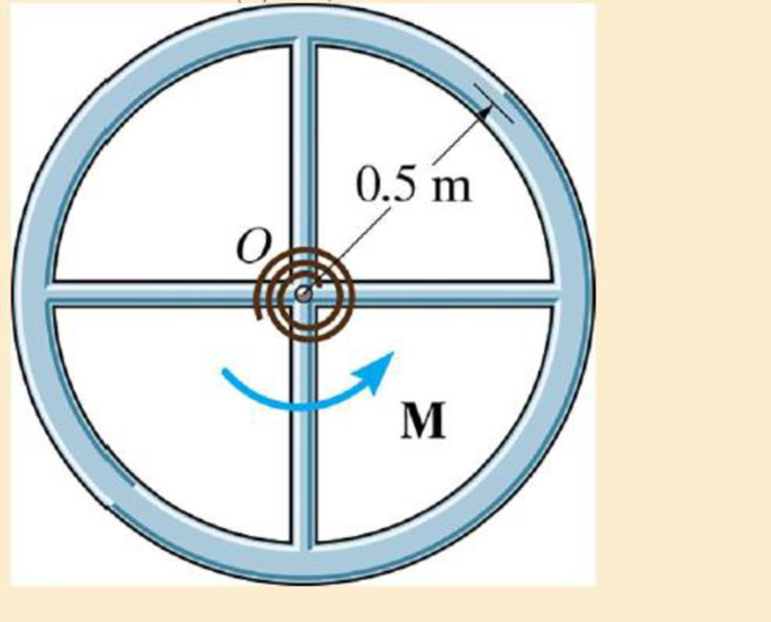
Engineering Mechanics: Statics & Dynamics (14th Edition)
14th Edition
ISBN: 9780133915426
Author: Russell C. Hibbeler
Publisher: PEARSON
expand_more
expand_more
format_list_bulleted
Concept explainers
Textbook Question
Chapter 18.4, Problem 3P
The wheel is made from a 5-kg thin ring and two 2-kg slender rods. If the torsional spring attached to the wheel's center has a stiffness k = 2 N · m/rad, so that the torque on the center of the wheel is M = (2θ) N · m, where θ is in radians, determine the maximum angular velocity of the wheel if it is rotated two revolutions and then released from rest

Expert Solution & Answer
Want to see the full answer?
Check out a sample textbook solution
Students have asked these similar questions
Please can you help me with the attached question?
Please can you help me with the attached question?
Please can you help me with the attached question?
Chapter 18 Solutions
Engineering Mechanics: Statics & Dynamics (14th Edition)
Ch. 18.4 - Determine the kinetic energy of the 100-kg object.Ch. 18.4 - The 80-kg wheel has a radius of gyration about its...Ch. 18.4 - The uniform 50-lb slender rod is subjected to a...Ch. 18.4 - The uniform 50-kg slender rod is at rest m the...Ch. 18.4 - The 50-kg wheel is subjected to a force of 50 N....Ch. 18.4 - If the uniform 30-kg slender rod starts from rest...Ch. 18.4 - The 20-kg wheel has a radius of gyration about its...Ch. 18.4 - At a given instant the body of mass m has an...Ch. 18.4 - The wheel is made from a 5-kg thin ring and two...Ch. 18.4 - The wheel is made from a 5-kg thin ring and two...
Ch. 18.4 - A force of P = 60 N is applied to the cable, which...Ch. 18.4 - A force of P = 20 N is applied to the cable, which...Ch. 18.4 - A force of P = 20 N is applied to the cable, which...Ch. 18.4 - The double pulley consists of two parts that are...Ch. 18.4 - The double pulley cons1sts of two parts that are...Ch. 18.4 - Prob. 9PCh. 18.4 - The spool has a mass of 40 kg and a radius of...Ch. 18.4 - Prob. 11PCh. 18.4 - Determine the velocity of the 50-kg cylinder after...Ch. 18.4 - The 10-kg uniform slender rod is suspended at rest...Ch. 18.4 - Prob. 14PCh. 18.4 - The pendulum consists of a 10-kg uniform disk and...Ch. 18.4 - A motor supplies a constant torque M = 6 kNm to...Ch. 18.4 - The center O of the thin ring of mass m is given...Ch. 18.4 - Prob. 18PCh. 18.4 - Prob. 19PCh. 18.4 - If P = 200 N and the 15-kg uniform slender rod...Ch. 18.4 - A yo-yo has a weight of 0.3 lb and a radius of...Ch. 18.4 - Prob. 22PCh. 18.4 - Prob. 23PCh. 18.4 - Prob. 24PCh. 18.4 - The 30-kg disk is originally at rest, and the...Ch. 18.4 - Two wheels of negligible weight are mounted at...Ch. 18.4 - Prob. 27PCh. 18.4 - The 10-kg rod AB is pin connected at A and...Ch. 18.4 - The 10-lb sphere starts from rest at = 0 and...Ch. 18.4 - Motor M exerts a constant force of P = 750 Non the...Ch. 18.4 - Prob. 31PCh. 18.4 - The linkage consists of two 6-kg rods AB and CD...Ch. 18.4 - The two 2-kg gears A and B are attached to the...Ch. 18.4 - The linkage consists of two 8-lb rods AB and CD...Ch. 18.4 - The linkage consists of two 8-lb rods AB and CD...Ch. 18.5 - F187. If the 30-kg disk is released from rest when...Ch. 18.5 - The 50-kg reel has a radius of gyration about its...Ch. 18.5 - The 60-kg rod OA is released from rest when = 0....Ch. 18.5 - Prob. 10FPCh. 18.5 - The 30-kg rod is released from rest when = 45....Ch. 18.5 - Prob. 12FPCh. 18.5 - Prob. 36PCh. 18.5 - Prob. 37PCh. 18.5 - An automobile tire has a mass of 7 kg and radius...Ch. 18.5 - The spool has a mass of 20 kg and a radius of...Ch. 18.5 - The spool has o mass of 20 kg and a radius of...Ch. 18.5 - A uniform ladder having a weight of 30 lb is...Ch. 18.5 - Prob. 44PCh. 18.5 - The 12-kg slender rod is attached to a spring,...Ch. 18.5 - Prob. 46PCh. 18.5 - The 40-kg wheel has a radius of gyration about its...Ch. 18.5 - The assembly consists of two 10-kg bars which are...Ch. 18.5 - The assembly consists of two 10-kg bars which are...Ch. 18.5 - The compound disk pulley consists of a hub and...Ch. 18.5 - Prob. 51PCh. 18.5 - Prob. 52PCh. 18.5 - The two 12-kg slender rods are pin connected and...Ch. 18.5 - If the 250-lb block is released from rest when the...Ch. 18.5 - The slender 15-kg bar is initially at rest and...Ch. 18.5 - If the chain is released from rest from the...Ch. 18.5 - Prob. 57PCh. 18.5 - Prob. 58PCh. 18.5 - The slender 6-kg bar AB is horizontal and at rest...Ch. 18.5 - Prob. 60PCh. 18.5 - Prob. 61PCh. 18.5 - The 50-lb wheel has a radius of gyration about its...Ch. 18.5 - The system consists of 60-lb and 20-lb blocks A...Ch. 18.5 - The door is made from one piece, whose ends move...Ch. 18.5 - Prob. 65PCh. 18.5 - Prob. 66PCh. 18.5 - Prob. 67PCh. 18.5 - The system consists of a 30-kg disk A, 12-kg...Ch. 18.5 - The pendulum of the Charpy impact machine has a...Ch. 18.5 - Prob. 2RPCh. 18.5 - The drum has a mass of 50 kg and a radius of...Ch. 18.5 - The spool has a mass of 60 Kg and a radius of...Ch. 18.5 - Prob. 5RPCh. 18.5 - At the Instant shown, the 50-lb bar rotates...Ch. 18.5 - Prob. 7RPCh. 18.5 - Prob. 8RP
Knowledge Booster
Learn more about
Need a deep-dive on the concept behind this application? Look no further. Learn more about this topic, mechanical-engineering and related others by exploring similar questions and additional content below.Similar questions
- Please can you help me with the attached question?arrow_forwardPlease can you help me with the attached question?arrow_forward4. The rod ABCD is made of an aluminum for which E = 70 GPa. For the loading shown, determine the deflection of (a) point B, (b) point D. 1.75 m Area = 800 mm² 100 kN B 1.25 m с Area = 500 mm² 75 kN 1.5 m D 50 kNarrow_forward
- Research and select different values for the R ratio from various engine models, then analyze how these changes affect instantaneous velocity and acceleration, presenting your findings visually using graphs.arrow_forwardQu. 7 The v -t graph of a car while travelling along a road is shown. Draw the s -t and a -t graphs for the motion. I need to draw a graph and I need to show all work step by step please do not get short cut from dtnaarrow_forwardAn unpressurized cylindrical tank with a 100-foot diameter holds a 40-foot column of water. What is total force acting against the bottom of the tank?arrow_forward
- 7. In the following problems check to see if the set S is a vector subspace of the corresponding R. If it is not, explain why not. If it is, then find a basis and the dimension. (a) S = (b) S = {[],+,"} X1 x12x2 = x3 CR³ {[1], 4+4 = 1} CR³ X2arrow_forwardAAA Show laplace transform on 1; (+) to L (y(+)) : SY(s) = x (0) Y(s) = £ [lx (+)] = 5 x(+) · est de 2 -St L [ y (^) ] = So KG) et de D 2 D D AA Y(A) → Y(s) Ŷ (+) → s Y(s) -yarrow_forward1) In each of the following scenarios, based on the plane of impact (shown with an (n, t)) and the motion of mass 1, draw the direction of motion of mass 2 after the impact. Note that in all scenarios, mass 2 is initially at rest. What can you say about the nature of the motion of mass 2 regardless of the scenario? m1 15 <+ m2 2) y "L χ m1 m2 m1 בז m2 Farrow_forward
- 8. In the following check to see if the set S is a vector subspace of the corresponding Rn. If it is not, explain why not. If it is, then find a basis and the dimension. X1 (a) S = X2 {[2], n ≤ n } c X1 X2 CR² X1 (b) S X2 = X3 X4 x1 + x2 x3 = 0arrow_forward2) Suppose that two unequal masses m₁ and m₂ are moving with initial velocities V₁ and V₂, respectively. The masses hit each other and have a coefficient of restitution e. After the impact, mass 1 and 2 head to their respective gaps at angles a and ẞ, respectively. Derive expressions for each of the angles in terms of the initial velocities and the coefficient of restitution. m1 m2 8 m1 ↑ บา m2 ñ Вarrow_forwardThe fallowing question is from a reeds book on applied heat i am studying. Although the answer is provided, im struggling to understand the whole answer and the formulas and the steps theyre using. Also where some ov the values such as Hg and Hf come from in part i for example. Please explain step per step in detail thanks In an NH, refrigerator, the ammonia leaves the evaporatorand enters the cornpressor as dry saturated vapour at 2.68 bar,it leaves the compressor and enters the condenser at 8.57 bar with50" of superheat. it is condensed at constant pressure and leavesthe condenser as saturated liquid. If the rate of flow of the refrigerantthrough the circuit is 0.45 kglmin calculate (i) the compressorpower, (ii) the heat rejected to the condenser cooling water in kJ/s,an (iii) the refrigerating effect in kJ/s. From tables page 12, NH,:2.68 bar, hg= 1430.58.57 bar, hf = 275.1 h supht 50" = 1597.2Mass flow of refrigerant--- - - 0.0075 kgls 60Enthalpy gain per kg of refrigerant in…arrow_forward
arrow_back_ios
SEE MORE QUESTIONS
arrow_forward_ios
Recommended textbooks for you
 Elements Of ElectromagneticsMechanical EngineeringISBN:9780190698614Author:Sadiku, Matthew N. O.Publisher:Oxford University Press
Elements Of ElectromagneticsMechanical EngineeringISBN:9780190698614Author:Sadiku, Matthew N. O.Publisher:Oxford University Press Mechanics of Materials (10th Edition)Mechanical EngineeringISBN:9780134319650Author:Russell C. HibbelerPublisher:PEARSON
Mechanics of Materials (10th Edition)Mechanical EngineeringISBN:9780134319650Author:Russell C. HibbelerPublisher:PEARSON Thermodynamics: An Engineering ApproachMechanical EngineeringISBN:9781259822674Author:Yunus A. Cengel Dr., Michael A. BolesPublisher:McGraw-Hill Education
Thermodynamics: An Engineering ApproachMechanical EngineeringISBN:9781259822674Author:Yunus A. Cengel Dr., Michael A. BolesPublisher:McGraw-Hill Education Control Systems EngineeringMechanical EngineeringISBN:9781118170519Author:Norman S. NisePublisher:WILEY
Control Systems EngineeringMechanical EngineeringISBN:9781118170519Author:Norman S. NisePublisher:WILEY Mechanics of Materials (MindTap Course List)Mechanical EngineeringISBN:9781337093347Author:Barry J. Goodno, James M. GerePublisher:Cengage Learning
Mechanics of Materials (MindTap Course List)Mechanical EngineeringISBN:9781337093347Author:Barry J. Goodno, James M. GerePublisher:Cengage Learning Engineering Mechanics: StaticsMechanical EngineeringISBN:9781118807330Author:James L. Meriam, L. G. Kraige, J. N. BoltonPublisher:WILEY
Engineering Mechanics: StaticsMechanical EngineeringISBN:9781118807330Author:James L. Meriam, L. G. Kraige, J. N. BoltonPublisher:WILEY

Elements Of Electromagnetics
Mechanical Engineering
ISBN:9780190698614
Author:Sadiku, Matthew N. O.
Publisher:Oxford University Press

Mechanics of Materials (10th Edition)
Mechanical Engineering
ISBN:9780134319650
Author:Russell C. Hibbeler
Publisher:PEARSON

Thermodynamics: An Engineering Approach
Mechanical Engineering
ISBN:9781259822674
Author:Yunus A. Cengel Dr., Michael A. Boles
Publisher:McGraw-Hill Education

Control Systems Engineering
Mechanical Engineering
ISBN:9781118170519
Author:Norman S. Nise
Publisher:WILEY

Mechanics of Materials (MindTap Course List)
Mechanical Engineering
ISBN:9781337093347
Author:Barry J. Goodno, James M. Gere
Publisher:Cengage Learning

Engineering Mechanics: Statics
Mechanical Engineering
ISBN:9781118807330
Author:James L. Meriam, L. G. Kraige, J. N. Bolton
Publisher:WILEY
First Law of Thermodynamics, Basic Introduction - Internal Energy, Heat and Work - Chemistry; Author: The Organic Chemistry Tutor;https://www.youtube.com/watch?v=NyOYW07-L5g;License: Standard youtube license